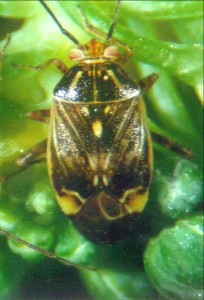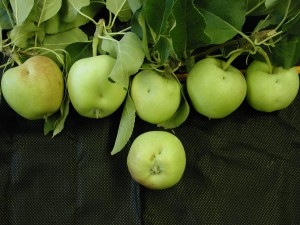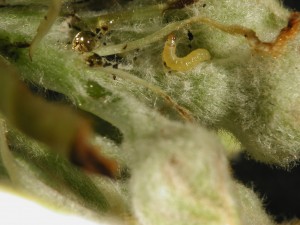Southern winds are predicted to begin coasting into the Hudson Valley with increasing temperatures into this weekend, bringing pome and stone fruit into bloom. We are seeing bloom in peach and pear with apple varieties in pink, a few open blossoms in Ginger Gold and Red Delicious. We will be in full bloom by weeks end if forecast temperatures into the mid to upper 70’s hold true.
Insects of primary concern this week include the San Jose Scale, Rosy apple aphid, Obliquebanded Leafroller, mullen plant bug and the tarnish plant bug. Plum curculio may be a problem if high temperatures (70’s for a number of days) drive them out of hibernation sites and into the orchard during the latter part of the week.
As overwintering success appears to be high in most insect groups this season given our cold and lingering winter and reasonable snow cover, it’s very likely that we will have strong pest populations this spring. We are certainly seeing this in the way of pear psylla. Lepidopteran larva are hatching and flower clusters are beginning to see injury.
The tarnished plant bug (TPB) Lygus lineolaris (Palisot de Beauvois), a pre-bloom pest of apple, is a true bug in the order Hemiptera, with piercing-sucking mouthparts such as is found in the cicadas, aphids, leafhoppers and mullen plant bug. Tarnish plant bug feeding has been observed in a number of orchard blocks last week, especially evident in pears with bleeding sites now evident of TPB feeding activity.
The adult TPB has a color appearance ranging from dull brown to black. The rear half of the forewings are membranous and are bent downward with a distinct yellow triangle behind the head (Image 2). The adult bugs hibernate under leaf liter, clover, alfalfa, mullein and protected places of stonewalls and tree bark. They become active at relatively low temperatures (> 46oF) with feeding becoming pronounced at temperature at or above 70oF, between tight cluster and bloom period of apple.
Tarnished plant bugs feed on a wide range of hosts including apple, apricot, cherry, pear, peach, plum and quince, small fruits such as strawberry and raspberry as well as flowers, vegetables and field crops. They have multiple generations per year. They can migrate into apple or stone fruit from another crop or weed host and should be assessed during the pre-bloom and early post bloom period to determine levels of activity. Orchards with weed host density are more prone to damage. Control of weed hosts, such as common mustard weed, has been shown to reduce fruit injury.
The tarnished plant bug causes injury to fruit during feeding and oviposition on developing fruit. Bleeding of sap occurs on flower and fruit stems, twig and shoot injury as TPB feed. On apple most eggs are laid in the developing fruit starting at bloom. The insect feeds first on buds and later on developing fruit resulting in small droplets of exudate on the surface of injured buds. Within 1 or 2 weeks, the flower clusters may appear dried and the leaves distorted, with a distinct hole where the insect fed. In general, later damage to developing fruit is more important than earlier feeding on flower buds. On apple, TPB feeding can cause punctures or deep dimples to form as the fruit develops, downgrading fruit quality. Most damage will occur near weedy areas, along ponds or wooded edge with broadleaf ground cover. This image of Gala damage occurred during early fruit development from pink through 1st cover. 
TPB management
To effectively monitor TPB, use unbaited, non-reflective, white sticky boards hung low in the tree canopy. Economic injury levels between trap captures and fruit injury show that 2% fruit injury will occur if 3.0 to 4.4 adult TPB are captured in white sticky traps(1). Most moderate density orchards can suffer up to 1% damage before economic injury occurs given the cost of management. Orchards growing 500 to 1000 bu./A can gain higher profitability margins using more conservative economic injury levels, especially growing higher valued varieties.
Economics 101: Prior to making specific applications for TPB, some background into profitability should be understood. Much depends on the actual price you receive for your fruit (known as the ‘Return To Grower’)2. If a single pre-bloom neonicotinoid, priced at >$20.00 per acre is used, and the RTG is less than the cost of the material, the result would be a net loss of profit.
For example; if you grow 500 bu./A and your return to grower (RTG) is $2.00 per bushel, your loss per acre from TPB is 1% or (5 bu.) and you would lose $10.00 / A if you did nothing. But if you made an application to manage TPB, and you reduced the damage from TPB by 1% by making a $20.00 per acre neonicotinoid application, you would gain $10.00 per acre in reduced damage to fruit but the cost of the $20.00 / A application would lose $10.00 in net profitability. The likelihood of effective insect pest management in reducing damage and attaining greater profitability should be based on the underlying profit margins for each orchard block. In highly valued varieties grown in high density planting systems, in which lower damage levels produce higher economic losses, conservative management strategies should be conducted. In low producing, low valued blocks, higher damage levels can be absorbed.
Unfortunately, we have no ‘soft’ insecticides available that are highly effective against the adult TPM. The pyrethroids (Asana, Ambush, Baythroid, Danitol, Pounce, Warrior ) are most effective, followed by the neonicotinoid group including Actara, Calypso Assail and Avaunt, which are moderately effective. Pyrethroids and neonicotinoids will also impact many of the insect pests damaging to fruit such as RAA, STLM and early immigrating PC. The overwintering OBLR will be reduced by the pyrethroids, however San Jose scale will mostly require an designated 1% oil application and or Esteem, Centaur or Lorsban application.
1. 1982. PROKOPY, RONALD J.; HUBBELL, GEOFFREY L.; ADAMS, ROGER G.; HAUSCHILD, KAREN I. Visual Monitoring Trap for Tarnished Plant Bug Adults on Apple
Source: Environmental Entomology, Volume 11, Number 1, February, pp. 200-203(4)
2. Return to growers (whole sale) = Profit paid to growers after growing costs, storage fees, pack out fees and marketing fees.


